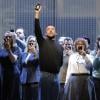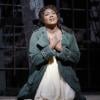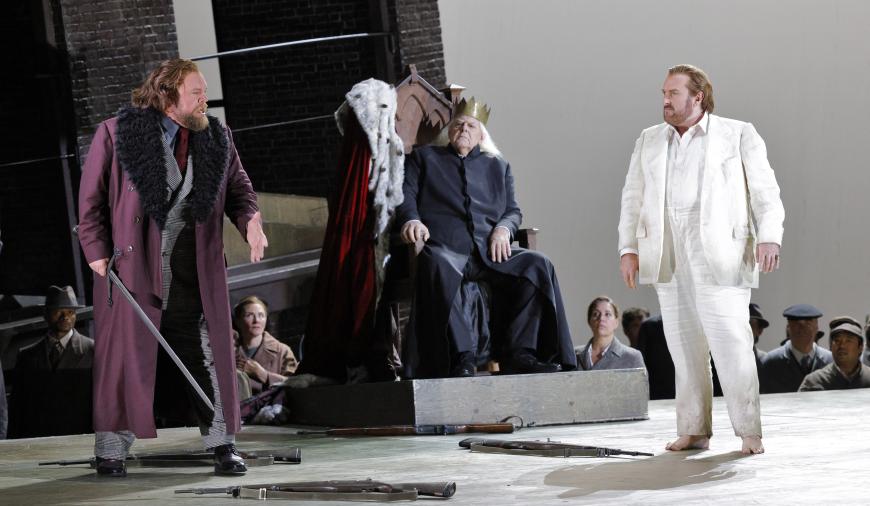
In 2022, San Francisco Opera Music Director Eun Sun Kim and General Director Matthew Shilvock revealed that Kim would conduct one opera by Giuseppe Verdi and one by Richard Wagner in each forthcoming season. She has already conducted Verdi’s La traviata and Il trovatore with winning results, and over the past several years, she has shown great strengths in works as diverse as Rusalka, Tosca, Dialogues of the Carmelites, and Antony and Cleopatra. But what would her Wagner be like?
With the opening of Lohengrin, the company’s third opera in the 2023–2024 season, we have our answer, and it’s a happy one. On Sunday, Kim led a magnificent performance of expansive grandeur, marked by musical coherence, sonic beauty, and a sense of inexorable forward movement. Lohengrin is long and full of complicated incidents and wordy exchanges among the characters. In the wrong hands it can be a slog, but between Kim’s alertness to the musical drama and the excellence of the cast, the performance was riveting from start to finish.

This was Kim’s first Lohengrin, and hers was one of several important debuts, all performed with the confidence of veterans. First among them was a sizzling, and sometimes terrifying, Ortrud from the Romanian-Hungarian mezzo-soprano Judit Kutasi, making her U.S., company, and role debuts. She brought a huge, beautifully controlled, vividly colorful voice and first-class acting to the role, easily dominating the stage and also her character’s husband, Friedrich von Telramund.
Former Adler Fellow Julie Adams made her role debut as Elsa, the naive young noblewoman whose brother’s disappearance sets the plot in motion when Elsa is accused of murdering him. A budding dramatic soprano, Adams has a richly colored voice, an even scale, sterling control at all dynamic levels, and the ability to sing with power or delicacy as the music demands. She and Kutasi both sang with a marvelous musical line and dramatically apt phrasing.
Baritone Brian Mulligan sang the King’s Herald in SF Opera’s 2012 production of Lohengrin, and now he has graduated to Telramund. You will not hear this role better sung, from Mulligan’s tonal beauty to his scrupulous legato and exemplary diction. He’s a singer who never shouts or snarls. In the large ensembles, he was sometimes hard to hear, but I’ll take all his virtues over sheer volume. His Telramund was thoughtful and less abject than most, seemingly aghast at his own sins even as he persists in plotting against Lohengrin.
Before the curtain went up on Sunday’s performance, Shilvock appeared, microphone in hand, to say a bit about the production. He acknowledged the conflicts in Israel and Gaza and the Russian invasion of Ukraine and then went on to note that director David Alden’s production of Lohengrin is set in a land that is becoming militarized because of its king’s obsession with raising an army. (You can see Shilvock’s comments on the SFO website, just above the synopsis of Lohengrin.)
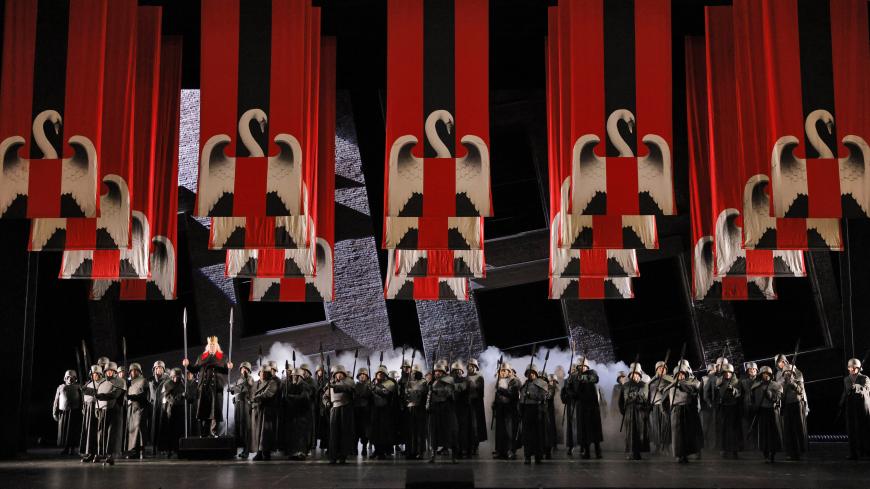
Everything Shilvock says is correct, and indeed the production makes for shocking viewing with its echoes of the onset of Nazism. In the opening scene, the chorus is dressed in 1930s street clothes and hats, and the set consists of towering, damaged brick buildings. Around the perimeter of the stage, armed soldiers stand at attention and then drive the crowd into a corner as King Heinrich (bass Kristinn Sigmundsson) comes onstage. Elsa crawls out from a trapdoor, and it’s clear that she has been held prisoner while awaiting trial. After no one steps forward to defend her, she’s blindfolded and chained to a wall as a firing squad assembles.
Over the course of the opera, the chorus makes Nazi-adjacent ritualized gestures. A giant swan statue looms over the end of Act 2, and in the last scenes of Act 3, red, white, and black swan banners dominate the stage. The King’s Herald, sung well by baritone Thomas Lehman, is a physically and emotionally damaged veteran with a visible head wound and braces on one arm and one leg. It’s a truly scary snapshot of a society in trouble.
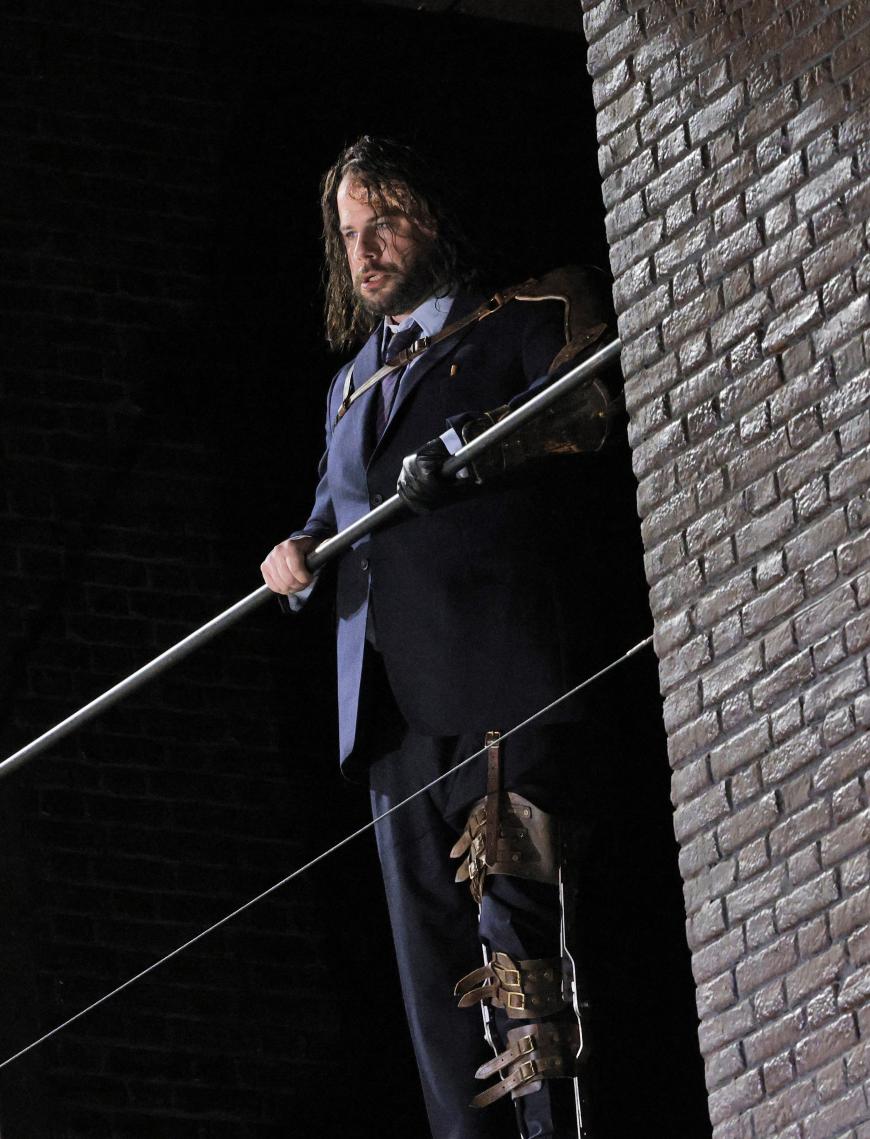
But it’s not clear where the militarism is coming from or what this really has to do with the libretto. Sigmundsson is 72, and no attempt has been made to disguise his age. His Heinrich has authority but does not seem militarily obsessed. What we know from the libretto is that after a nine-year truce, Heinrich is trying to unite various political factions out of concern over an invasion by the Hungarians. Legitimate self-defense need not lead to fascism. Perhaps this particular point would work with a younger and more vigorous Heinrich.
Could Lohengrin’s presence be the cause of the militarism? The opera takes place over a period of about three days, which is a remarkably short time in which to adopt Lohengrin’s swan as a national or nationalist symbol. Lohengrin himself is consistently presented as a good, noble, pure individual without personal ambition. He’s in Brabant to defend Elsa and refuses the title of duke in favor of “protector.”
Regardless, within this framework, most of the drama works out reasonably well. Ortrud, the last of a noble line of pagans, is a bureaucrat of some kind, and her scene with Friedrich in Act 2 takes place in a dimly lit office. She is very clearly in charge of their relationship. Lohengrin arrives just in time to keep Elsa from being killed. Rather than a boat drawn by a swan, he arrives out of a giant and scary projection of threshing wings, for some reason without his sword, horn, and ring and in a white outfit that has seen better days. In his first fight with Telramund, he wins through sheer personal force, never laying a hand on his opponent. In the last act, though, he wrests Telramund’s sword from him. A couple of events take place outside the proscenium and aren’t visible from all seats, such as a wedding celebration in the orchestra-level aisles during the Act 3 Prelude. And if you can see Box A, which is to the audience’s left and closest to the stage, glance over there at the very end of Act 2.
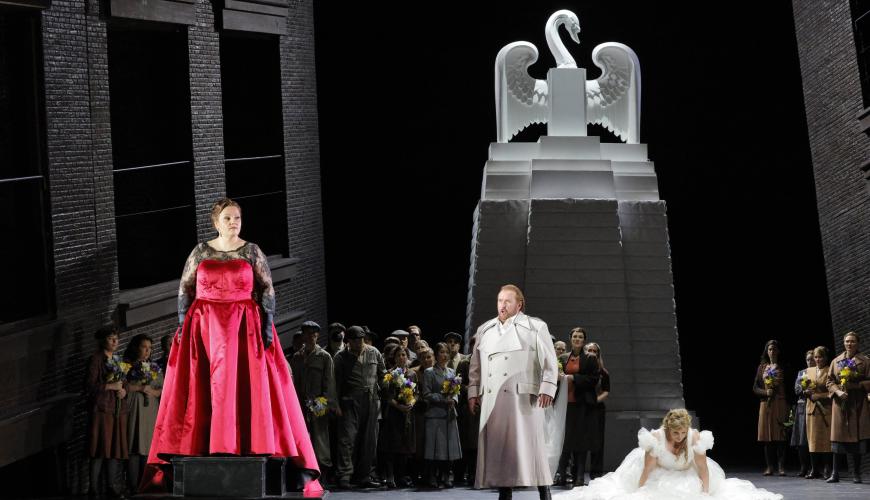
Tenor Simon O’Neill, a 2002 Merola alumnus, plays Lohengrin, singing musically with a big, penetrating voice that’s more notable for sturdiness than for beauty. You might wish for a tenor with more personal charisma in this role, the canonical knight in shining armor. The direction does little to make up for this.
The chorus has an enormous role to play in Lohengrin, narrating Lohengrin’s arrival and other crucial events of the opera. This production has a chorus of 79, and it’s a magnificent ensemble, singing with force and precision throughout.
Shilvock has promised us a Ring cycle in a few seasons, and given Kim’s outstanding results with Lohengrin, we can only look forward eagerly to her annual Wagner outings. Even if you can’t see the Lohengrin production in person — and you should try — you can livestream it for $27.50 on Saturday, Oct. 21, at 7 p.m. PT. Performances run through Nov. 1.



